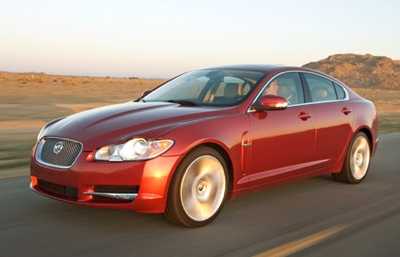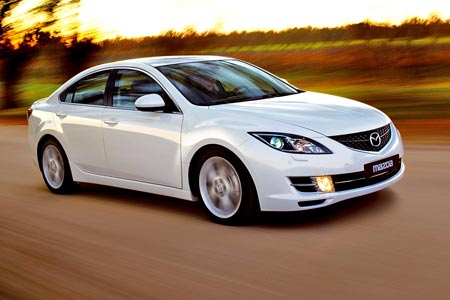Acura TSX

Exterior: The car is slightly angular, with a v-shaped grille and ample rear. The dorsal fin on the top and dual tailpipes take cues from vehicles in higher price brackets.
Interior: Inside, several dials on the dash and multiple buttons on the steering wheel, door and center console could be distracting for some drivers. Room in the back is on the small side.
Handling: The car drives sufficiently for a mid-range sedan. Steering is adequate, although the four-cylinder is noticeably less sporty than the six. The feel of the brakes takes some getting used to.
BMW 535i xDrive

Exterior: The 5-Series has a wide hood, gathered rear and classic BMW grille. It's got BMW's unflashy but intimidating look--an unmistakable force on the road.
Interior: The 5-Series combines the best of 3-Series handling with larger cargo and passenger space, and more power. Standard features include head-up display, Bluetooth capability, navigation/traffic alert and an easy-to-use, premium sound system.
Handling: It feels a bit heavier to drive than Mercedes' E-Class but is closer to the road and feels brawnier. Very controlled around corners and during braking.
BMW M3
Exterior: The car is instantly recognizable by the power bulge under the hood and the side gills with "M3" badge. The marque is a welcome sight to drivers who know their stuff.
Interior: Like all BMWs, the M3 sedan is utilitarian on the inside--and that's a good thing. All accoutrement--from the tachometer and multi-function M-specialized steering wheel to the adjustable arm rests--are focused on empowering the driver. The phone/radio/navigation system is much improved. The rear seat is adequate but not large. Head room is fair.
Handling: Handling, braking and ride in the M3 are virtually unparalleled in its class. It has speed-sensitive variable-assist power steering, pressurized front struts and rear shock absorbers, all-season traction control and a high-performance brake system. The car responds well to changing conditions and buckles down immediately when speed is needed.
Hyundai Genesis

Exterior: The big, new grille and hidden badge on the Genesis mark it as something apart from the line's other, economy-minded vehicles. Chrome trim and optional XX rims complete a look on par with Lexus and Audi.
Interior: Plush seats, a luxurious-feeling steering wheel, a quiet cabin and extras like navigation and satellite technology are a joy. Hyundai has also done well with the little things: Door handles feel smooth, knobs are unobtrusive and elevated rear seats create a sense of difference.
Handling: The car drives like what it is--a large sedan that can feel heavy at times but controlled. Zero-to-60 speed was 6.8 seconds.
Jaguar XF Supercharged
Exterior: The XF is an attempt by Jaguar to make the old brand new while staying true to its design roots. The fat grille and swept-back end are distinctive, with (for better or worse) more personality than some Asian vehicles in the same segment.
Interior: Jaguar is clearly making an effort with the XF at luxury. Inside, surround sound, soft-grain leather seats, contrast stitching and loads of tech add to the plush feel.
Handling: The XF Supercharged has bold power--470 hp--and a huge V8 engine. Acceleration is strong, but the car doesn't feel as light or nimble as some of its counterparts from BMW and Mercedes-Benz.
Mazda 6
Exterior: The second-gen Mazda6 is gently rounded on the outside, with a sloping roofline, RX-8-inspired fenders and optional LED taillights, which lend sportiness to the sedan. Integrated side sills, chrome accents and standard halogen (optional xenon) headlights with auto shut-off are a plus.
Interior: The 6 has a certain cool factor over some of its competitors. Optional "welcome" lighting on the dash, comfortable seats and intuitively placed controls add to the ease of driving without becoming distractions. Heated seats and a huge trunk are a definite plus; the back seats have enough room to be practical.
Handling: The steering and braking are refreshingly straightforward, with not-overly-cushy suspension. It's a bigger sedan, so it's not as nimble as some of its competitors, but the footing around corners is stable and controlled.
Mercedes-Benz E550

Interior: If you're a tech nut or someone who doesn't want to have to think about driving, you'll love this car--it does everything for you. It has adaptive high beams, drowsy driver assist, voice control and a rear-seat entertainment system. And the minute you sit down, cushy leather seats envelop your back and thighs, with an arm rest perfectly positioned to give the ideal support. For better or worse: The E-Class makes you forget you're driving.
Handling: The car gains speed smoother than anything we've driven in a long time. The cabin is quiet, and the car handles well around corners.
Mercedes-Benz S400h

Exterior: The S400 is an elegant car for wealthy drivers in search of something that conveys class. Its smooth lines and trim go hand-in-hand with its overall suave demeanor.
Interior: First-adopters and rich techno-geeks will love this car. It has it all: Adaptive high beam assist, a voice-activated command system, Bluetooth, brake assist, 8-inch (large, by comparison to others) computer screens, rear-seat entertainment, heated and ventilated leather front seats, a panorama sunroof and wood walnut trim. We could go on ...
Handling: The acceleration in Mercedes cars is second to none, and the automaker kept up the good work with its mild hybrid version. The ride is ultra quiet and floaty, which is a significant accomplishment for the world's first production-level lithium-ion battery in a sedan.
Subaru Legacy 3.6R
Exterior: It's not flashy, but the utilitarian exterior and strong, stable body lines communicate reliability and trustworthiness.
Interior: The inside of the Legacy is roomy and durable, with manual 60/40 split seating, some brushed silver trim and cloth upholstery. It's not exactly bare-bones inside, but it's certainly necessities-only. The interior lends itself to carting dogs, gear and kids.
Handling: The car feels wide to drive, with Subaru's special boxer engine and AWD. It's not going to win any races, but it does great in the snow and has ample torque.
Toyota Prius

Exterior: The Prius was lambasted when it first came out by critics who said people bought the hybrid in spite of its looks, instead of because of them. That may be true, but the unique body style and hatchback rear end made this car instantly recognizable to eco-minded drivers and spelled a green-car coup for Toyota. Plus, the hatchback style frees up generous cargo space in the rear. It also has ample headroom in the front.
Interior: The videogame-like dashboard computer shows when and how the battery is charging; power windows and smart-key entry, plus ample cup holders and arm rests make the car very practical as a daily driver. Space in the rear hatch is generous. Leather seats are standard on some trim levels.
Handling: The quiet Prius isn't going to win any drag races (it gets to 60 miles per hour in just under 10 seconds), but at a combined 51 mpg in the city, who cares? Acceleration is smooth and constant; corners can be a bit jilted but, in general, are easy to handle at anything but the highest of speeds.



No comments:
Post a Comment